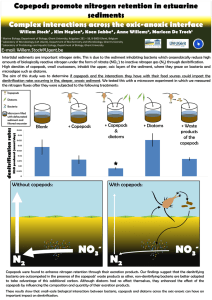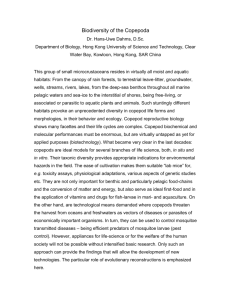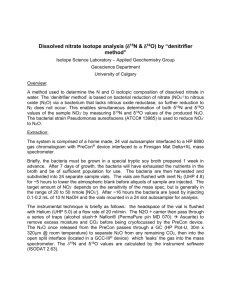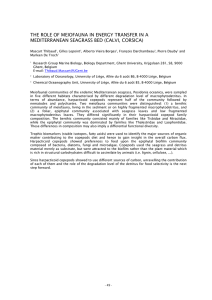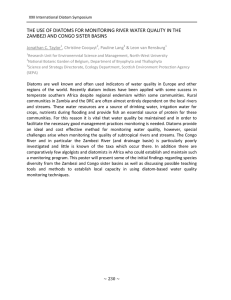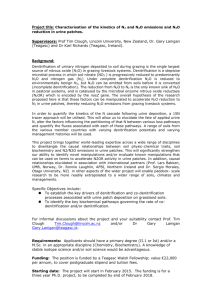Interactions between Benthic Copepods, Bacteria and
advertisement
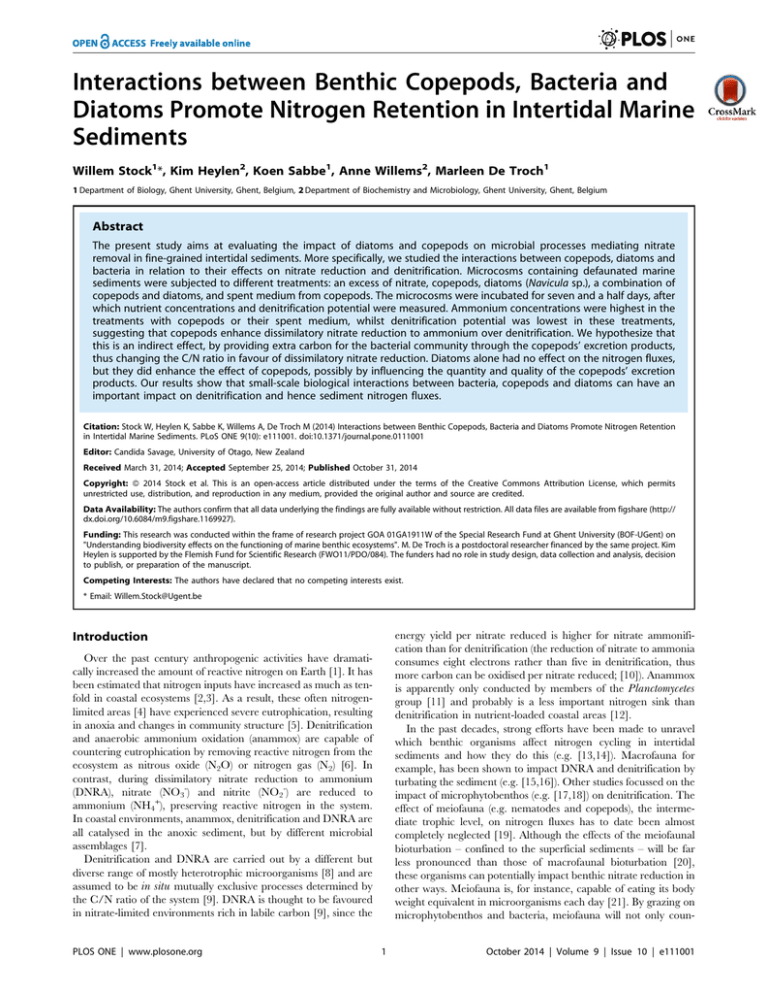
Interactions between Benthic Copepods, Bacteria and
Diatoms Promote Nitrogen Retention in Intertidal Marine
Sediments
Willem Stock1*, Kim Heylen2, Koen Sabbe1, Anne Willems2, Marleen De Troch1
1 Department of Biology, Ghent University, Ghent, Belgium, 2 Department of Biochemistry and Microbiology, Ghent University, Ghent, Belgium
Abstract
The present study aims at evaluating the impact of diatoms and copepods on microbial processes mediating nitrate
removal in fine-grained intertidal sediments. More specifically, we studied the interactions between copepods, diatoms and
bacteria in relation to their effects on nitrate reduction and denitrification. Microcosms containing defaunated marine
sediments were subjected to different treatments: an excess of nitrate, copepods, diatoms (Navicula sp.), a combination of
copepods and diatoms, and spent medium from copepods. The microcosms were incubated for seven and a half days, after
which nutrient concentrations and denitrification potential were measured. Ammonium concentrations were highest in the
treatments with copepods or their spent medium, whilst denitrification potential was lowest in these treatments,
suggesting that copepods enhance dissimilatory nitrate reduction to ammonium over denitrification. We hypothesize that
this is an indirect effect, by providing extra carbon for the bacterial community through the copepods’ excretion products,
thus changing the C/N ratio in favour of dissimilatory nitrate reduction. Diatoms alone had no effect on the nitrogen fluxes,
but they did enhance the effect of copepods, possibly by influencing the quantity and quality of the copepods’ excretion
products. Our results show that small-scale biological interactions between bacteria, copepods and diatoms can have an
important impact on denitrification and hence sediment nitrogen fluxes.
Citation: Stock W, Heylen K, Sabbe K, Willems A, De Troch M (2014) Interactions between Benthic Copepods, Bacteria and Diatoms Promote Nitrogen Retention
in Intertidal Marine Sediments. PLoS ONE 9(10): e111001. doi:10.1371/journal.pone.0111001
Editor: Candida Savage, University of Otago, New Zealand
Received March 31, 2014; Accepted September 25, 2014; Published October 31, 2014
Copyright: ß 2014 Stock et al. This is an open-access article distributed under the terms of the Creative Commons Attribution License, which permits
unrestricted use, distribution, and reproduction in any medium, provided the original author and source are credited.
Data Availability: The authors confirm that all data underlying the findings are fully available without restriction. All data files are available from figshare (http://
dx.doi.org/10.6084/m9.figshare.1169927).
Funding: This research was conducted within the frame of research project GOA 01GA1911W of the Special Research Fund at Ghent University (BOF-UGent) on
"Understanding biodiversity effects on the functioning of marine benthic ecosystems". M. De Troch is a postdoctoral researcher financed by the same project. Kim
Heylen is supported by the Flemish Fund for Scientific Research (FWO11/PDO/084). The funders had no role in study design, data collection and analysis, decision
to publish, or preparation of the manuscript.
Competing Interests: The authors have declared that no competing interests exist.
* Email: Willem.Stock@Ugent.be
energy yield per nitrate reduced is higher for nitrate ammonification than for denitrification (the reduction of nitrate to ammonia
consumes eight electrons rather than five in denitrification, thus
more carbon can be oxidised per nitrate reduced; [10]). Anammox
is apparently only conducted by members of the Planctomycetes
group [11] and probably is a less important nitrogen sink than
denitrification in nutrient-loaded coastal areas [12].
In the past decades, strong efforts have been made to unravel
which benthic organisms affect nitrogen cycling in intertidal
sediments and how they do this (e.g. [13,14]). Macrofauna for
example, has been shown to impact DNRA and denitrification by
turbating the sediment (e.g. [15,16]). Other studies focussed on the
impact of microphytobenthos (e.g. [17,18]) on denitrification. The
effect of meiofauna (e.g. nematodes and copepods), the intermediate trophic level, on nitrogen fluxes has to date been almost
completely neglected [19]. Although the effects of the meiofaunal
bioturbation – confined to the superficial sediments – will be far
less pronounced than those of macrofaunal bioturbation [20],
these organisms can potentially impact benthic nitrate reduction in
other ways. Meiofauna is, for instance, capable of eating its body
weight equivalent in microorganisms each day [21]. By grazing on
microphytobenthos and bacteria, meiofauna will not only coun-
Introduction
Over the past century anthropogenic activities have dramatically increased the amount of reactive nitrogen on Earth [1]. It has
been estimated that nitrogen inputs have increased as much as tenfold in coastal ecosystems [2,3]. As a result, these often nitrogenlimited areas [4] have experienced severe eutrophication, resulting
in anoxia and changes in community structure [5]. Denitrification
and anaerobic ammonium oxidation (anammox) are capable of
countering eutrophication by removing reactive nitrogen from the
ecosystem as nitrous oxide (N2O) or nitrogen gas (N2) [6]. In
contrast, during dissimilatory nitrate reduction to ammonium
(DNRA), nitrate (NO3-) and nitrite (NO2-) are reduced to
ammonium (NH4+), preserving reactive nitrogen in the system.
In coastal environments, anammox, denitrification and DNRA are
all catalysed in the anoxic sediment, but by different microbial
assemblages [7].
Denitrification and DNRA are carried out by a different but
diverse range of mostly heterotrophic microorganisms [8] and are
assumed to be in situ mutually exclusive processes determined by
the C/N ratio of the system [9]. DNRA is thought to be favoured
in nitrate-limited environments rich in labile carbon [9], since the
PLOS ONE | www.plosone.org
1
October 2014 | Volume 9 | Issue 10 | e111001
Copepods-Diatoms Interactions and Nitrate Reduction
which the spent medium from copepods was added to the
microcosm.
Together with the positive control (increased NO3-), this
resulted in a total of six different treatments.
Each treatment starting with a microcosm containing 80 g of
defaunated and thawed sediment: (1) Blank: +70 ml FSW; (2)
Increased NO3-: +0.1 mmol KNO3 in 70 ml FSW; (3) Copepod: +
200 phototactic copepods collected from Paulina Polder in 70 ml
FSW; (4) Diatom: +46105 cells of Navicula sp. (36.2762.30 mm;
isolated from the study site in 2012) in 70 ml FSW (corresponds to
chlorophyll a concentrations observed in the study site.); (5)
Copepod+diatom: +46105 cells of Navicula sp. and 200 copepods
(as above) in 70 ml FSW; (6) Spent medium:+70 ml of FSW, in
which 200 copepods were fed 46105 Navicula cells over a period
of one week. A visual (microscopic) screening of the treatments
revealed that most diatoms had been eaten by the copepods after
one week. Prior to the start of the treatment this spent medium was
stored at 220uC after manually removing the copepods.
One hour after the start of the experiment, 10 ml of water was
extracted for nutrient analysis (initial nutrient concentration) from
each microcosm. All microcosms were then incubated for 7.5 days,
at 15uC.
To study the effects of the photosynthetic activity of the diatoms
on the nitrogen fluxes, all treatments were run (1) under a diurnal
(12 h/12 h) light regime and (2) in the dark. Cold-white
fluorescent lamps provided the necessary light at a rate of 20–
25 mmol photons m22 s21. Four replicates were used for each
treatment under each light condition. To avoid depletion of active
nitrogen in the microcosms, half of the SW was renewed on day 5
and 6 of the experiment. At the end of the incubation period,
10 ml of SW was stored for nutrient analysis (final nutrient
concentration).
An additional experiment was setup in which the blank and
copepod+diatom treatment were repeated to verify the effects of
copepods and diatoms on the oxygen pentration depths (Text S1).
Denitrification rates were measured using the so-called acetylene inhibition method [27][16] (cf. Fig S1 which illustrates the
design of the experiment). In the presence of acetylene the final
reaction of denitrification, in which N2O is converted to N2, is
inhibited, causing N2O to accumulate. The easily quantifiable
N2O can then be measured as a proxy for denitrification. The rate
at which NO3- is consumed is a good proxy for the combined
activity of all three reduction pathways.
At the end of each treatment, a serum vial was filled with 30 g
(wet weight) sediment and 20 ml incubation water (collected from
the treatments; Fig S1). To prevent nitrogen and carbon
limitation, the water was supplemented with 0.5 mmol KNO3
and 1 mmol a-D-glucose. After vigorous shaking, 1 ml was
extracted to determine the initial NO3-/NO2- concentration (t0).
The vials were hermetically sealed and flushed five times with
helium to remove oxygen. After adding 10% acetylene, the vials
were incubated at 25uC under a constant stirring rate of 90 rpm.
The N2O concentrations were measured every two hours by
injecting 1 ml of headspace in a GC-TCD (Gas ChromatographyThermal Conductivity Detector; MICRO E-0391, Interscience;
LOD 13.55 ppm N2O). This was done at four time points (t1–t4)
for each serum vial (Fig. S1). N2O concentrations were corrected
for headspace volume changes, pressure and dissolving of the gas
into the liquid phase. To ascertain potential side-effects of
acetylene [28], the process was repeated with a technical replicate
without acetylene (data not shown). At the second (t2) and final
sampling event (t4) from the replicate without acetylene, 800 ml of
fluid was extracted for later NO3-/NO2- determination (indicative
for the NO3- reduction activity; Fig. S1).
teract the effects of the microphytobenthos and bacteria on nitrate
reduction, but also release high amounts of organic nitrogen and
carbon [22] into the interstitial environment, thus potentially
impacting the C/N ratio. We hypothesized that the meiofauna can
impact nitrogen reduction in marine sediments through their
grazing activity. The aim of this study was therefore to investigate
the impact of meiofauna and its interactions with its food sources,
diatoms and bacteria, on denitrification in marine sediments. For
this purpose an experiment was setup in which all possible
combinations of meiofauna, diatoms and bacteria were included.
Harpactecoid copepods were used as meiofauna representative
since they occur in high densities at the study site (2306194 ind.
10 cm-2, [23]) and have been well-studied in terms of both
composition [23] and feeding ecology (e.g. [24–26]) in this tidal
flat.
In the experiment, both nitrate reduction (the combined activity
of denitrification, DNRA and anammox) and denitrification as
such were measured as these biochemical reactions are relevant
and important ecosystem functions in coastal sediments. Furthermore, nitrate reduction and denitrification can serve as proxies for
the overall functioning of the benthic microbial community. In
microcosm experiments with sediment, harpacticoid copepods
(Crustacea, Copepoda) and diatoms from an intertidal flat (Paulina
Polder, Westerschelde estuary, The Netherlands), nutrient dynamics and the potential for nitrate reduction and denitrification
were monitored. Nitrate reduction and denitrification rates could
not be measured in situ, as they are largely anaerobic processes
whilst copepods are strictly aerobic. Both rates were therefore
measured indirectly by making a subsample of the homogenised
microcosm anaerobic and measuring the potential rates under
non-carbon or -nitrogen limiting conditions.
Methodology
Field sampling
Silty sediment was collected from the intertidal mudflat Paulina
(Westerschelde estuary, The Netherlands; 51u209 N, 3u439 E) in
February 2013 by scraping the top layer (0–3 cm) of the sediment
at low tide. Seawater (salinity: 19.3; 1.8561.11 mM NO2;
122.0268.17 mM NO3-; 2.5061.70 mM NH4+; 0.7360.60 mM
PO43-; 88.8960.16 mM Si4+; N = 3) was collected from the same
site and was filtered over a 0.22 mm filter (Corning 500 mL Bottle
Top Vacuum Filter) and stored in the dark at 4uC (filtered
seawater: FSW). No permits were required for the sampling nor
were there any endangered or protected species involved.
Experimental setup
Collected sediment was washed over a 250 mm sieve to remove
all benthic fauna. The sieved sediment (average median grain size:
56.8960.25 mm; N = 3) was divided in equal aliquots of 80 g in
polyethylene containers (microcosms). The microcosms with
62.5 cm of sieved sediment were stored frozen (220uC) to kill
all the remaining fauna. A microcosm was defrosted two days
before the start of a treatment. After adding 60 ml of filtered
seawater (FSW), the thawed sediment was thoroughly mixed.
Right before the start of a treatment, the FSW was drained off.
The experimental design included a blank: the defaunated
sediment in which only bacteria were present. To verify the effect
of copepods and diatoms, independently of one another, on the
bacteria, they were added separately to the microcosm. To cover
the interaction effects between copepods and diatoms, both of
them were added to the microcosm. In order to discriminate
between the effects of the activity of the copepods themselves and
the waste products that they produce, a treatment was included in
PLOS ONE | www.plosone.org
2
October 2014 | Volume 9 | Issue 10 | e111001
Copepods-Diatoms Interactions and Nitrate Reduction
(after collecting the cells with the lens-tissue method) and pulseamplitude modulation (PAM; Maxi-Imaging PAM M-series, Walz)
showed healthy and active diatom cells. Visual observations
showed active copepods in all microcosms of the copepod and
copepod + diatom treatment.
Nutrient analysis
Nutrient concentrations (NO3-, NO2-, NH4+ and PO4-) of the
samples collected at the start and the end of the incubation period
(initial and final nutrient concentration) were analysed with an
automatic chain (SAN plus segmented flow analyser, SKALAR)
according to Beyst et al. [29].
Samples extracted from the serum vials for NO3-/NO2determination were analysed differently because the above used
method required higher sample volumes. The samples were
centrifuged (14000 rpm, 5 min) and the supernatants were stored
frozen (220uC) prior to analysis. Analysis of NO3- and NO2- was
based on a colorimetric method as described by Cataldo et al.
[30], based on Griess [31] with adjustments from NavarroGonzálvez et al. [32].
Nutrient levels
Initial nutrient concentrations. Except for the spent
medium and the increased NO3- treatment, the initial nutrient
concentrations in the microcosms did not differ among treatments
(ANOVA; p,0.05; Table 1). The nitrate concentration in the
spent medium was significantly lower than in the other treatments,
while in the increased NO3- treatment, the nitrate concentration
was, as expected, significantly higher. Nitrite was significantly
lower in the spent medium and in the increased NO3- treatment.
The initial ammonium concentration was highest in the copepod +
diatom treatment, but the difference was only significant
compared to the increased NO3- treatment. In contrast, the
phosphate concentration in the spent medium treatment was 2.5–
4 times higher than in the other treatments.
Final nutrient concentrations. After 7.5 days of incubation,
the nutrient concentrations did not differ significantly between
light conditions (two-way ANOVA; p.0.05).
At the end of the incubation period, nitrate and nitrate were
almost completely depleted in all treatments (on average
1.1260.03 mM and 0.3060.01 mM, respectively; Table 1), despite
renewal of half of the SW on days 5 and 6. The ammonium
concentration more or less quadrupled towards the end of the
experiment (average 384.0863.04 mM). The final ammonium
concentration in the copepod treatment was significantly higher
than in the diatom and the blank treatment. The final ammonium
concentration in the copepod + diatom treatment was the highest
of all treatments, although it was not significantly different from
the other treatments due to considerable variation between the
replicates.
The same pattern was observed in the final phosphate
concentrations. The phosphate concentrations strongly increased
during the incubation period as the final average phosphate
concentration (18.6060.21 mM) was almost twenty times higher
than the initial one.
Data analysis
The software package R 2.15.0. was used for data analysis.
Differences in initial and final nutrient concentrations between the
treatments and light conditions were detected using a two-way
ANOVA on the rank transformed concentrations, performed in
the software package R 2.15.0. Pairwise differences were
unravelled using Dunnett’s Modified Tukey-Kramer Pairwise
Multiple Comparison Test (DTK) [33] using 95% confidence
limits.
N2O production rates and NO3- reduction rates were calculated
according to both Magalhaes et al. [34], assuming no bacterial
growth between the N2O, respectively NO3-/NO2-, samplings (i.e.
between t0 and t4), and Stenström et al. [35], assuming that
bacterial growth does occur. Magalhaes et al. [34] obtained the
N2O production rates by dividing the N2O concentration at t4 by
t4. Stenström et al. [35], however, propose an exponential
regression to accommodate for the increasing gas production rate
rN2O mt
(e {1), with p = the
between samplings: p(t)~p0 z
m
amount of gas at time t, p0 = the amount of product at t0, rN2O
= the N2O production rate (see below) and m = the specific
growth rate constant. Since the serum vials were flushed with
helium, there was no N2O at the start of the incubation and p0 was
set to zero. This function was adapted to fit the data for the NO3rNO3 mt
(e {1), with s =
reduction (in the serum vials) to s(t)~s0 {
m
the amount of substrate (NO3-) at time t, s0 = the amount of
substrate at t0 and rNO3 = the initial NO3- reduction rate, further
referred to as ‘‘NO3- reduction rate’’.
The N2O production rates (rN2O) obtained from the regression
analysis are the production rates of N2O at the start (t0) of the
denitrification potential experiment, i.e. after the 7.5 days
incubation period (Fig. S1). Likewise, the initial NO3- reduction
rates (rNO3) express the NO3- reduction rate at the start of the
denitrification potential experiment. Thus the rates are corrected
for any microbial growth occurring after the NO3- and glucose
addition.
Differences in the obtained N2O production and the NO3reduction rates between the different treatments and light
conditions were analysed using a permutation-based two-way
ANOVA [36] since the data were not normally distributed.
Pairwise differences were analyzed using Wilcoxon rank-sum posthoc test using 95% confidence limits, with Bonferroni correction.
Potential for nitrate reduction and denitrification
During the measurement of the denitrification potential, nitrate
was consumed, while nitrite and nitrous oxide were produced (see
Fig. S2 for the average NO3-, NO2- and N2O concentrations
during the measurement of the denitrification potential). Since the
exponential function proposed by Stenström et al. [35] had a
significantly better fit than the linear regression proposed by
Magalhaes et al. [34], rates were calculated with the exponential
function.
The NO3- reduction and N2O production rates did not differ
between light conditions. In contrast to the NO3- reduction rate,
which did not differ between treatments (Fig 1, black bars), the
N2O production rate did significantly differ between the
treatments (p,0.01; Fig. 1, white bars). The N2O production
rate was significantly lower for the copepod + diatom treatment
compared to the blank (p,0.001), diatom (p,0.001), increased
NO3- (p,0.001) and spent medium (p,0.001) treatments.
The correlation between N2O production and NO3- reduction
rates was weak but significantly positive (Pearson’s r = 0.30, p,
0.05).
Results
Viability
At the end of the incubation, viability of copepods and diatoms
were checked in all treatments. Both microscopic observations
PLOS ONE | www.plosone.org
3
October 2014 | Volume 9 | Issue 10 | e111001
34.33610.63
Spent medium
c
131.1762.95
Copepod+diatom
a
1135.296258.98
Increased
NO3Blank
PLOS ONE | www.plosone.org
Significant differences of the ANOVAs indicated with symbols (*** #0.001,** #0.01,* #0.05, ,0.1). The different superscripted letters indicate significant differences (P,0.05; DTK) between the treatments. Light conditions
(not shown) did not alter the outcome of treatments (see text).
doi:10.1371/journal.pone.0111001.t001
26.2962.53b
2.4460.30
425.93616.24
94.4366.97
0.1760.05
1.4260.32
0.6560.31
13.7961.83a
23.2762.36b
25.9862.61b
0.6660.09
b
ab
ab
485.69634.52
78.1662.25
0.6560.18
4.3960.27
1.4360.58
c
a
ab
b
a
0.9460.17a
372.18621.35a
ab
0.2060.03
4.1760.14a
0.7660.21
130.8664.04a
Diatom
ab
18.9061.90
15.3061.74
400.71622.01
467.1969.70b
ab
105.5665.06
89.1366.27
0.3260.06
0.2560.03
3.4360.21
4.4860.21a
0.8360.24
424.176265.21a
Copepod
1.2960.36
88.9766.75
0.9860.16a
0.7560.11
a
ab
a
b
2.2460.79
b
Final***
Initial***
0.8560.13a
360.03624.42a
0.2360.10
4.3560.20a
Final
Initial***
125.9365.00a
Treatments
99.6766.54ab
Initial*
Final̇
Initial***
Final**
PO43-, mean ±SE (mM)
NH4+, mean ±SE (mM)
NO2-, mean ±SE (mM)
NO3-, mean ±SE (mM)
Nutrients
Table 1. Initial and final nutrient concentrations of the different treatments.
a
Copepods-Diatoms Interactions and Nitrate Reduction
Discussion
Effect of copepods
The presence of copepods or their spent medium resulted in
elevated phosphate and ammonium concentrations in the
microcosms. The copepods’ outfluxes (including excretion products, moults, remnants of sloppy feeding) therefore proved to be an
important source of both N and P which are, in coastal areas,
potentially limiting nutrients [37].
Contrary to macrofauna, not much is known about the impact
of meiofauna on nitrogen fluxes. Macrofauna seems to have its
biggest impact through bioturbation (e.g. [15]). However, the
oxygen penetration depth did not increase in the presence of
copepods (Text S1), and consequently the effects of copepods are
not related to oxygen. Since the N2O production rates of the
copepod and their spent medium treatments were low, the
copepods appeared to negatively impact denitrification, at least
partially via their outfluxes. The outfluxes of the copepods are,
apart from being an important nutrient source, a source of organic
compounds and hence a substrate for bacterial growth [38]. Since
organic matter loading may be one of the most important variables
controlling denitrification in aquatic ecosystems [39], the impact of
these carbon outfluxes should not be underestimated. The
copepod outfluxes contain high amounts of labile carbon [22],
which are known to stimulate DNRA over denitrification and
anammox (Fig. 2, dashed arrow 1; [9]). Copepods can also
indirectly stimulate labile carbon production by mechanically
breaking down detrital particles [40,41]. In addition, more organic
matter results in a higher sulphate reduction rate (Fig. 2, dashed
arrow 2; [42]). The main product of sulphate reduction is
hydrogen sulphide, which inhibits denitrification and nitrification,
but not DNRA [7]. These findings are supported by the higher
final ammonium concentrations in the treatments with copepods
or their spent medium. Furthermore, the NO3- reduction rate did
not differ significantly between the treatments, suggesting that the
reduced denitrification activity in the treatments with copepods or
their spent medium was compensated by another nitrate reducing
process.
Effects of diatoms
Since there were no differences between the final nitrate, nitrite
and ammonium concentrations of the blank and the diatom
treatment, diatoms seemed to have no net effect on the nitrogen
fluxes in the microcosm. Likewise, N2O production rates did not
differ between the blank and the diatom treatment either. It thus
appears that diatoms had no or very little impact on denitrification
in the microcosms. This is inconsistent with previous reports,
where the presence of benthic microalgae generally had a negative
impact on denitrification rates [43] as microalgae outcompeted the
bacteria for nitrogen [18]. The opposite has however also been
observed (e.g. [44]) were microalgae enhanced denitrification. It is2
unlikely that the inoculation concentration (26105 diatoms/cm )
used in this study was too low to have a significant effect on the
denitrification rate as it was comparable to the diatom concentrations in other studies were diatoms did have an effect on the
nitrogen fluxes (e.g. [18]). It is, however, possible that positive and
negative effects of the diatoms cancelled each other out or that the
overall effect was too small to be detected. However, one should
bear in mind that the used incubation time might be too short to
obtain strong effects caused by the diatoms [18,45].
Effects of diatoms + copepods
The negative effect of the copepods on denitrification was most
pronounced and only significant when diatoms were added to the
4
October 2014 | Volume 9 | Issue 10 | e111001
Copepods-Diatoms Interactions and Nitrate Reduction
Figure 1. NO3- reduction and N2O production rates. NO3- reduction rate (black bars; left y-axis) and N2O production rates (white bars; right yaxis) during the measurement of the denitrification potential for the different treatments (mean 6 SE; cop. = copepods; cop. + dia. = copepod+
diatom). The different letters above the bar indicate significant differences (P,0.05; DTK) between the treatments. Light conditions (not shown) did
not affect the outcome of treatments.
doi:10.1371/journal.pone.0111001.g001
system. This suggests an important interaction effect between
diatoms and copepods. Since the diatoms themselves had no effect
on denitrification and nitrate reduction, it is unlikely that they
were directly responsible for the difference between the copepods
+ diatoms and the copepods treatments. The diatoms can,
however, influence the composition of the copepod outfluxes
(Fig. 2, dashed arrow 4), which depends on the food type [22]. As
diatoms are thought to be a better food source for copepods than
bacteria (e.g. [26,46]), they might also enhance the survival of the
copepods and, accordingly, their activity and the quantity of the
excretion products (Fig. 2, dashed arrows 3–4).
Figure 2. Summary of the assumed interactions to explain the observed differences in N2O production rates. The assumed interactions
which affect denitrification are indicated with dashed arrows. Bacteria mediated relevant reduction reactions of the nitrogen pathway and sulfur
pathway are enclosed by grey boxes indicated with respectively ‘N fluxes’ and ‘S fluxes’. Copepods feed on both diatoms and bacteria, and produce
excretion producs (excretions). Bacteria feed on the excretion produces and are also responsible for the reduction of SO42- to H2S and of NO3- to NH4+
(DNRA) and N2O+N2 (denitrification) in the microcosm. The produced NH4+ is assimilated by both bacteria and diatoms. Copepods affect the N2O
production rate by producing excretion products which provide an extra carbon source, of which mainly the DNRA bacteria can take advantage (1)
and also enhances SO42- reduction (2a), which results in more H2S. The increased H2S inhibits denitrification (2b). Diatoms have no direct effect on the
N2O production rate, but do have an indirect effect by enhancing the survival of the copepods (3) and influencing the quantity and composition of
the copepods’ excretion products (4).
doi:10.1371/journal.pone.0111001.g002
PLOS ONE | www.plosone.org
5
October 2014 | Volume 9 | Issue 10 | e111001
Copepods-Diatoms Interactions and Nitrate Reduction
Supporting Information
Effects of the nitrate addition
The N2O production rate for the increased NO3- treatment was
unexpectedly similar to the blank. In general, the denitrification
rate is positively influenced by the nitrate load (e.g. [47,48]), but
such a relation was not observed here. However, a preliminary test
in which we used a shorter, three and a half day long incubation
period showed that the N2O production rate was almost twice as
high for the increased NO3- treatment compared to the blank
(data not shown). This indicates that the supplemented nitrate was
depleted within the first few days and that the denitrifying
community changed accordingly.
Figure S1 Design of the denitrification potential exper-
iment. Incubation steps are indicated by dotted arrows.
Manipulations are indicated by a dashed arrow. Each microcosm
(here represented as a rectangle) was incubated for 7.5 days, after
which water (blue) and sediment (brown) were transferred from the
microcosm to the serum vials (represented as trapezoids). Glucose
and potassium nitrate were added to the vial after which it was
thoroughly homogenized. The headspace was flushed with helium
to remove oxygen, after which acetylene was injected. The vials
were sampled four times for N2O determination, every two hours.
(DOC)
Final considerations
Figure S2 NO3-, NO2- and N2O concentrations in the
serum vials after the addition of 0.5 mmol KNO3 during
the measurement of the denitrification potential (from
t0 to t4). Amounts (mmol/h/g sediment) are averaged over all
samples (all treatments), as is the time at with the sample was taken
(Time; h:min) 6 SE. N2O concentration(blue) plotted on the right
y axis; NO3- (red) and NO2- (green) concentrations on the left y
axis.
(DOC)
Our findings have potentially important implications for our
understanding of nutrient fluxes in marine sediment and the role
of meiofauna. It was already known that meiofauna facilitates
biomineralization of organic material and enhances nutrient
regeneration [40]. This is an indirect process, by stimulating the
bacterial community [40] through the production of excretion
products [49] and bioturbation [40]. The present study suggests
that these processes may also negatively impact denitrification.
Consequently, more active nitrogen will be preserved in the
ecosystem in the presence of meiofauna. Furthermore, they also
increase the freely available phosphorus and carbon (this study,
[22]). These elevated nutrient levels will benefit both bacteria and
microphytobenthos. Our observations should, however, be interpreted with care as they were obtained from a short-term
microcosm experiment. They might therefore not be representative for the highly dynamic estuarine sediments these organisms
where obtained from. Our results do, however, prove that the
interactions between meiofauna, diatoms and bacteria can
potentially impact the nitrogen fluxes and that they should
therefore not be neglected in future research. The time-dependent
effect of the increased NO3- treatment clearly illustrates the
importance of the temporal scale in this setup. It might therefore
prove useful for further research to investigate the effects of the
different treatments at different time intervals. Furthermore,
additional experiments (for instance relying on the 15N technique;
[50]) will be necessary to fully unravel these fine-scale interactions.
Text S1 Measurement of oxygen penetration depth. To
verify the effects of copepods and diatoms on the oxygen
pentration depths, the experiment as described in the method
section was repeated for the blank, diatom and copepod+diatom
treatment. The methodology and results of the additional
experiment are shown here.
(DOCX)
Acknowledgments
Evie De Brandt, Bram Vekeman, Sven Hoefman and Dirk Van Gansbeke
are acknowledged for their assistance with the lab analyses. Frederik De
Laender is acknowledged for his help with the regressions and improving
the R-script. The authors thank the 2 reviewers for their comments that
helped improve and clarify this manuscript.
Author Contributions
Conceived and designed the experiments: WS KH KS AW MDT.
Performed the experiments: WS. Analyzed the data: WS. Contributed
reagents/materials/analysis tools: MDT AW KS. Wrote the paper: WS
KH KS AW MDT.
References
9. Burgin AJ, Hamilton SK (2007) Have we overemphasized the role of
denitrification in aquatic ecosystems? A review of nitrate removal pathways.
Frontiers in Ecology and the Environment 5: 89–96.
10. Strohm TO, Griffin B, Zumft WG, Schink B (2007) Growth yields in bacterial
denitrification and nitrate ammonification. Applied and environmental microbiology 73: 1420–1424.
11. Jetten MS, Wagner M, Fuerst J, van Loosdrecht M, Kuenen G, et al. (2001)
Microbiology and application of the anaerobic ammonium oxidation (‘anammox’) process. Current opinion in biotechnology 12: 283–288.
12. Teixeira C, Magalhaes C, Joye SB, Bordalo AA (2012) Potential rates and
environmental controls of anaerobic ammonium oxidation in estuarine
sediments. Aquatic Microbial Ecology 66: 23–32.
13. Risgaard-Petersen N (2003) Coupled nitrification-denitrification in autotrophic
and heterotrophic estuarine sediments: On the influence of benthic microalgae.
Limnology and Oceanography 48: 93–105.
14. Ferguson A, Eyre B (2013) Interaction of benthic microalgae and macrofauna in
the control of benthic metabolism, nutrient fluxes and denitrification in a shallow
sub-tropical coastal embayment (western Moreton Bay, Australia). Biogeochemistry 112: 423–440.
15. Braeckman U, Provoost P, Gribsholt B, Van Gansbeke D, Middelburg JJ, et al.
(2009) Role of macrofauna functional traits and density in biogeochemical fluxes
and bioturbation. Marine Ecology Progress Series 399: 173.
16. Binnerup SJ, Jensen K, Revsbech NP, Jensen MH, Sørensen J (1992)
Denitrification, dissimilatory reduction of nitrate to ammonium, and nitrification
1. Leach AM, Galloway JN, Bleeker A, Erisman JW, Kohn R, et al. (2012) A
nitrogen footprint model to help consumers understand their role in nitrogen
losses to the environment. Environmental Development 1: 40–66.
2. Paerl HW (2006) Assessing and managing nutrient-enhanced eutrophication in
estuarine and coastal waters: Interactive effects of human and climatic
perturbations. Ecological Engineering 26: 40–54.
3. Pätsch J, Serna A, Dähnke K, Schlarbaum T, Johannsen A, et al. (2010)
Nitrogen cycling in the German Bight (SE North Sea)—Clues from modelling
stable nitrogen isotopes. Continental Shelf Research 30: 203–213.
4. Howarth RW, Marino R (2006) Nitrogen as the limiting nutrient for
eutrophication in coastal marine ecosystems: evolving views over three decades.
Limnology and Oceanography 51: 364–376.
5. Koop-Jakobsen K, Giblin AE (2010) The effect of increased nitrate loading on
nitrate reduction via denitrification and DNRA in salt marsh sediments.
Limnology and Oceanography 55: 789.
6. Schreiber F, Wunderlin P, Udert KM, Wells GF (2012) Nitric oxide and nitrous
oxide turnover in natural and engineered microbial communities: biological
pathways, chemical reactions, and novel technologies. Front Microbiol 3: 372.
7. An S, Gardner WS (2002) Dissimilatory nitrate reduction to ammonium
(DNRA) as a nitrogen link, versus denitrification as a sink in a shallow estuary
(Laguna Madre/Baffin Bay, Texas). Marine Ecology Progress Series 237.
8. Herbert R (1999) Nitrogen cycling in coastal marine ecosystems. FEMS
microbiology reviews 23: 563–590.
PLOS ONE | www.plosone.org
6
October 2014 | Volume 9 | Issue 10 | e111001
Copepods-Diatoms Interactions and Nitrate Reduction
17.
18.
19.
20.
21.
22.
23.
24.
25.
26.
27.
28.
29.
30.
31.
32.
33.
in a bioturbated estuarine sediment as measured with 15N and microsensor
techniques. Applied and environmental microbiology 58: 303–313.
Christensen PB, Nielsen LP, Sørensen J, Revsbech NP (1990) Denitrification in
nitrate-rich streams: diurnal and seasonal variation related to benthic oxygen
metabolism. Limnology and Oceanography 35: 640–651.
Risgaard-Petersen N, Nicolaisen MH, Revsbech NP, Lomstein BA (2004)
Competition between ammonia-oxidizing bacteria and benthic microalgae. Appl
Environ Microbiol 70: 5528–5537.
Parent S, Morin A (1999) Role of copepod-dominated meiofauna in the
nitrification process of a cold marine mesocosm. Canadian Journal of Fisheries
and Aquatic Sciences 56: 1639–1648.
Martin P, Boes X, Goddeeris B, Fagel N (2005) A qualitative assessment of the
influence of bioturbation in Lake Baikal sediments. Global and Planetary
Change 46: 87–99.
Montagna PA (1984) In situ measurement of meiobenthic grazing rates on
sediment bacteria and edaphic diatoms. Marine ecology progress series
Oldendorf 18: 119–130.
Frangoulis C, Christou ED, Hecq JH (2005) Comparison of marine copepod
outfluxes: nature, rate, fate and role in the carbon and nitrogen cycles. Adv Mar
Biol 47: 253–309.
Cnudde C, De Troch M. unpubl. data.
De Troch M, Houthoofd L, Chepurnov V, Vanreusel A (2006) Does sediment
grain size affect diatom grazing by harpacticoid copepods? Mar Environ Res 61:
265–277.
De Troch M, Vergaerde I, Cnudde C, Vanormelingen P, Vyverman W, et al.
(2012) The taste of diatoms: the role of diatom growth phase characteristics and
associated bacteria for benthic copepod grazing. Aquatic Microbial Ecology 67:
47–58.
Cnudde C, Moens T, Hoste B, Willems A, De Troch M (2013) Limited feeding
on bacteria by two intertidal benthic copepod species as revealed by trophic
biomarkers. Environ Microbiol Rep 5: 301–309.
Sørensen J (1978) Capacity for denitrification and reduction of nitrate to
ammonia in a coastal marine sediment. Applied and Environmental Microbiology 35: 301–305.
Groffman PM, Altabet MA, Böhlke J, Butterbach-Bahl K, David MB, et al.
(2006) Methods for measuring denitrification: diverse approaches to a difficult
problem. Ecological Applications 16: 2091–2122.
Beyst B, Hostens K, Mees J (2001) Factors influencing fish and macrocrustacean
communities in the surf zone of sandy beaches in Belgium: temporal variation.
Journal of Sea Research 46: 281–294.
Cataldo D, Maroon M, Schrader L, Youngs V (1975) Rapid colorimetric
determination of nitrate in plant tissue by nitration of salicylic acid 1.
Communications in Soil Science & Plant Analysis 6: 71–80.
Griess P (1879) Bemerkungen zu der Abhandlung der HH. Weselsky und
Benedikt ’’Ueber einige Azoverbindungen’’ . Berichte der deutschen chemischen
Gesellschaft 12: 426–428.
Navarro-Gonzálvez JA, Garcı́a-Benayas C, Arenas J (1998) Semiautomated
measurement of nitrate in biological fluids. Clinical chemistry 44: 679–681.
Lau M (2009) DTK: Dunnett–Tukey–Kramer pairwise multiple comparison test
adjusted for unequal variances and unequal sample sizes. R package version 2.
PLOS ONE | www.plosone.org
34. Magalhaes CM, Machado A, Matos P, Bordalo AA (2011) Impact of copper on
the diversity, abundance and transcription of nitrite and nitrous oxide reductase
genes in an urban European estuary. FEMS Microbiol Ecol 77: 274–284.
35. Stenström J, Hansen A, Svensson B (1991) Kinetics of microbial growthassociated product formation. Swedish Journal of Agricultural Research
(Sweden).
36. Wheeler B (2010) lmPerm: Permutation tests for linear models. R package
version 1.1–2.
37. Vadstein O, Andersen T, Reinertsen HR, Olsen Y (2012) Carbon, nitrogen and
phosphorus resource supply and utilisation for coastal planktonic heterotrophic
bacteria in a gradient of nutrient loading. Mar Ecol Prog Ser 447: 55–75.
38. De Troch M, Cnudde C, Willems A, Moens T, Vanreusel A (2010) Bacterial
colonization on fecal pellets of harpacticoid copepods and on their diatom food.
Microbial ecology 60: 581–591.
39. Cornwell JC, Kemp WM, Kana TM (1999) Denitrification in coastal
ecosystems: methods, environmental controls, and ecosystem level controls, a
review. Aquatic Ecology 33: 41–54.
40. Coull BC (1999) Role of meiofauna in estuarine soft-bottom habitats*.
Australian Journal of Ecology 24: 327–343.
41. Nascimento FJ, Näslund J, Elmgren R (2012) Meiofauna enhances organic
matter mineralization in soft sediment ecosystems. Limnology and Oceanography 57: 338.
42. Berner RA, Westrich JT (1985) Bioturbation and the early diagenesis of carbon
and sulfur. American Journal of Science 285: 193–206.
43. Sundbäck K, Miles A, Linares F (2006) Nitrogen dynamics in nontidal littoral
sediments: Role of microphytobenthos and denitrification. Estuaries and coasts
29: 1196–1211.
44. An S, Joye SB (2001) Enhancement of coupled nitrification-denitrification by
benthic photosynthesis in shallow estuarine sediments. Limnology and
Oceanography 46: 62–74.
45. Nilsson P, Jonsson B, Swanberg IL, Sundback K (1991) Response of a marine
shallow-water sediment system to an increased load of inorganic nutrients.
Marine Ecology Progress Series MESEDT 71.
46. Sundbäck K, Nilsson P, Nilsson C, Jönsson B (1996) Balance between
autotrophic and heterotrophic components and processes in microbenthic
communities of sandy sediments: a field study. Estuarine, Coastal and Shelf
Science 43: 689–706.
47. Bartoli M, Castaldelli G, Nizzoli D, Viaroli P (2012) Benthic primary production
and bacterial denitrification in a Mediterranean eutrophic coastal lagoon.
Journal of Experimental Marine Biology and Ecology 438: 41–51.
48. Koch M, Maltby E, Oliver G, Bakker S (1992) Factors controlling denitrification
rates of tidal mudflats and fringing salt marshes in south-west England.
Estuarine, Coastal and Shelf Science 34: 471–485.
49. De Troch M, Steinarsdóttir MB, Chepurnov V, Ólafsson E (2005) Grazing on
diatoms by harpacticoid copepods: species-specific density-dependent uptake
and microbial gardening. Aquatic microbial ecology 39: 135–144.
50. Giblin AE, Tobias CR, Song B, Weston N, Banta GT, et al. (2013) The
importance of dissimilatory nitrate reduction to ammonium (DNRA) in the
nitrogen cycle of coastal ecosystems.
7
October 2014 | Volume 9 | Issue 10 | e111001
